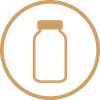Lysozyme, also known as muramidase, is an enzyme belonging to the hydrolase group, which is found in saliva, sweat, tears, nasal and intestinal mucous membranes and blood plasma. The enzyme, which is also found in animals, plants and certain viruses, is primarily responsible for the initial, non-specific defence against pathogens.
Bromelain, papain and ficin are purely plant-based enzymes that have protein-degrading properties. By breaking down proteins, they support plants in their defence against insects, bacteria and other pests. Bromelain is a name for a group of enzymes from plants of the genus Bromeliaceae.
Our enzyme complex is synergistically supported by a number of specific secondary plant substances: the flavonoids quercetin, rutin, OPC and citrus flavonoids as well as the polyphenol resveratrol. As plant pigments, these substances are responsible for the colouring of flowers and leaves as well as for protecting plants from certain environmental influences. Flavonoids are therefore formed to a greater extent under more difficult conditions (e.g., rutin in the case of increased UV radiation or infestation with microorganisms).
Quercetin is particularly concentrated in the outer layers of plants and fruits, for example in grapes, apples or onions. The Japanese pagoda tree (Sophora japonica) in particular contains exceptionally high amounts.
Rutin is a yellow-coloured secondary phytochemical similar to quercetin. Many plant foods contain rutin: figs, asparagus, citrus fruit peels, apples, cherries, berries (blueberries, cranberries, goji berries), buckwheat and green and black teas. In addition to the Japanese pagoda tree, other plants and herbs such as white mulberry, red vine leaves, rue, St John's wort and parsley are also very rich in rutin.
OPC (short for oligomeric proanthocyanidins), also known as vitamin P, is a group of flavonols consisting of polymers of catechins and epicatechins. Proanthocyanidins are found in a whole range of fruits and plants, including the seeds and skins of grapes, berries and citrus fruits as well as in the protective bark of trees.
Resveratrol is also a plant polyphenol and has already been discovered in more than 72 plant species. It became known as a naturally occurring component of red wine. It is particularly concentrated in the skins of red grapes and serves the plant as a natural defence and protective substance against parasites, fungal attacks and adverse weather conditions such as moisture, UV radiation and temperature fluctuations.


















